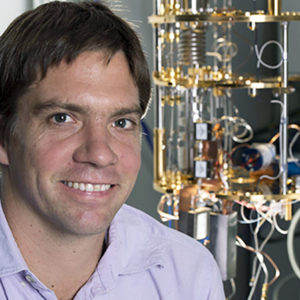Thermodynamics is one of the most human of scientific enterprises, according to Kater Murch, associate professor of physics in Arts & Sciences at Washington University in St. Louis.
“It has to do with our fascination of fire and our laziness,” he said. “How can we get fire” — or heat — “to do work for us?”
Now, Murch and colleagues have taken that most human enterprise down to the intangible quantum scale — that of ultra low temperatures and microscopic systems — and discovered that, as in the macroscopic world, it is possible to use information to extract work.

There is a catch, though: Some information may be lost in the process.
“We’ve experimentally confirmed the connection between information in the classical case and the quantum case,” Murch said, “and we’re seeing this new effect of information loss.”
The results were published in the July 20 issue of Physical Review Letters.
The international team included Eric Lutz of the University of Stuttgart; J. J. Alonzo of the University of Erlangen-Nuremberg; Alessandro Romito of Lancaster University; and Mahdi Naghiloo, a Washington University graduate research assistant in physics.
That we can get energy from information on a macroscopic scale was most famously illustrated in a thought experiment known as Maxwell’s Demon. The “demon” presides over a box filled with molecules. The box is divided in half by a wall with a door. If the demon knows the speed and direction of all of the molecules, it can open the door when a fast-moving molecule is moving from the left half of the box to the right side, allowing it to pass. It can do the same for slow particles moving in the opposite direction, opening the door when a slow-moving molecule is approaching from the right, headed left.
After a while, all of the quickly-moving molecules are on the right side of the box. Faster motion corresponds to higher temperature. In this way, the demon has created a temperature imbalance, where one side of the box is hotter. That temperature imbalance can be turned into work — to push on a piston as in a steam engine, for instance. At first the thought experiment seemed to show that it was possible create a temperature difference without doing any work, and since temperature differences allow you to extract work, one could build a perpetual motion machine — a violation of the second law of thermodynamics.
“Eventually, scientists realized that there’s something about the information that the demon has about the molecules,” Murch said. “It has a physical quality like heat and work and energy.”
His team wanted to know if it would be possible to use information to extract work in this way on a quantum scale, too, but not by sorting fast and slow molecules. If a particle is in an excited state, they could extract work by moving it to a ground state. (If it was in a ground state, they wouldn’t do anything and wouldn’t expend any work).
But they wanted to know what would happen if the quantum particles were in an excited state and a ground state at the same time, analogous to being fast and slow at the same time. In quantum physics, this is known as a superposition.
“Can you get work from information about a superposition of energy states?” Murch asked. “That’s what we wanted to find out.”
There’s a problem, though. On a quantum scale, getting information about particles can be a bit … tricky.
“Every time you measure the system, it changes that system,” Murch said. And if they measured the particle to find out exactly what state it was in, it would revert to one of two states: excited, or ground.
This effect is called quantum backaction. To get around it, when looking at the system, researchers (who were the “demons”) didn’t take a long, hard look at their particle. Instead, they took what was called a “weak observation.” It still influenced the state of the superposition, but not enough to move it all the way to an excited state or a ground state; it was still in a superposition of energy states. This observation was enough, though, to allow the researchers track with fairly high accuracy, exactly what superposition the particle was in — and this is important, because the way the work is extracted from the particle depends on what superposition state it is in.
To get information, even using the weak observation method, the researchers still had to take a peek at the particle, which meant they needed light. So they sent some photons in, and observed the photons that came back.
“But the demon misses some photons,” Murch said. “It only gets about half. The other half are lost.” But — and this is the key — even though the researchers didn’t see the other half of the photons, those photons still interacted with the system, which means they still had an effect on it. The researchers had no way of knowing what that effect was.
They took a weak measurement and got some information, but because of quantum backaction, they might end up knowing less than they did before the measurement. On the balance, that’s negative information.
And that’s weird.
“Do the rules of thermodynamics for a macroscopic, classical world still apply when we talk about quantum superposition?” Murch asked. “We found that yes, they hold, except there’s this weird thing. The information can be negative.
“I think this research highlights how difficult it is to build a quantum computer,” Murch said.
“For a normal computer, it just gets hot and we need to cool it. In the quantum computer you are always at risk of losing information.”
This research was funded by the National Science Foundation, the Office of Naval Research, the John Templeton Foundation and the Engineering and Physical Sciences Research Council.